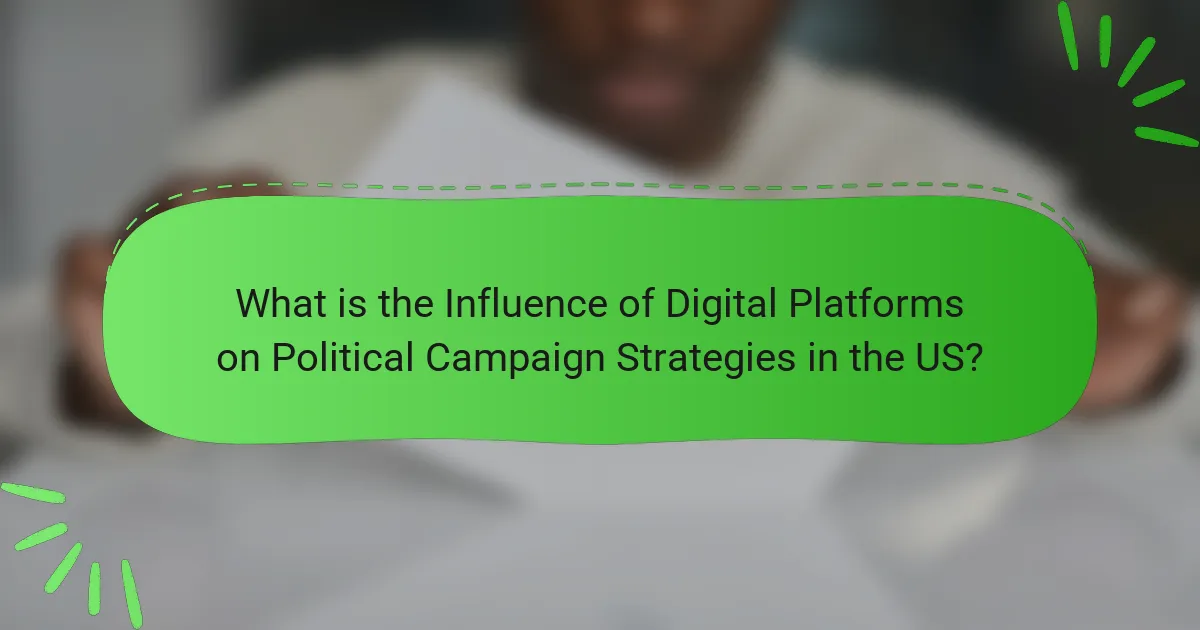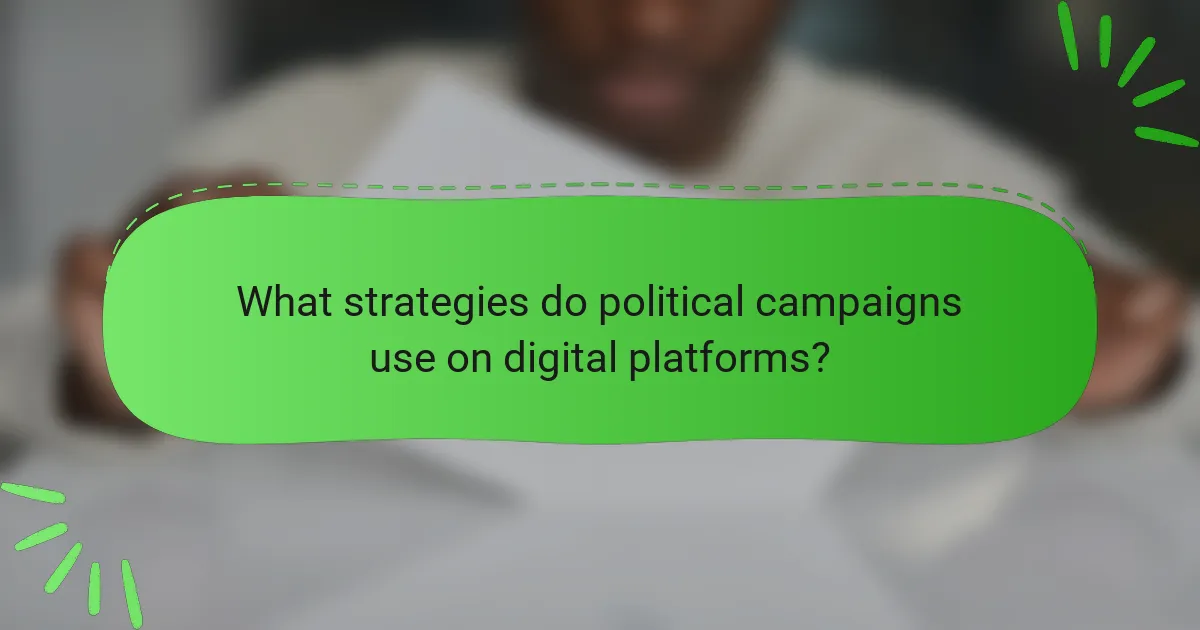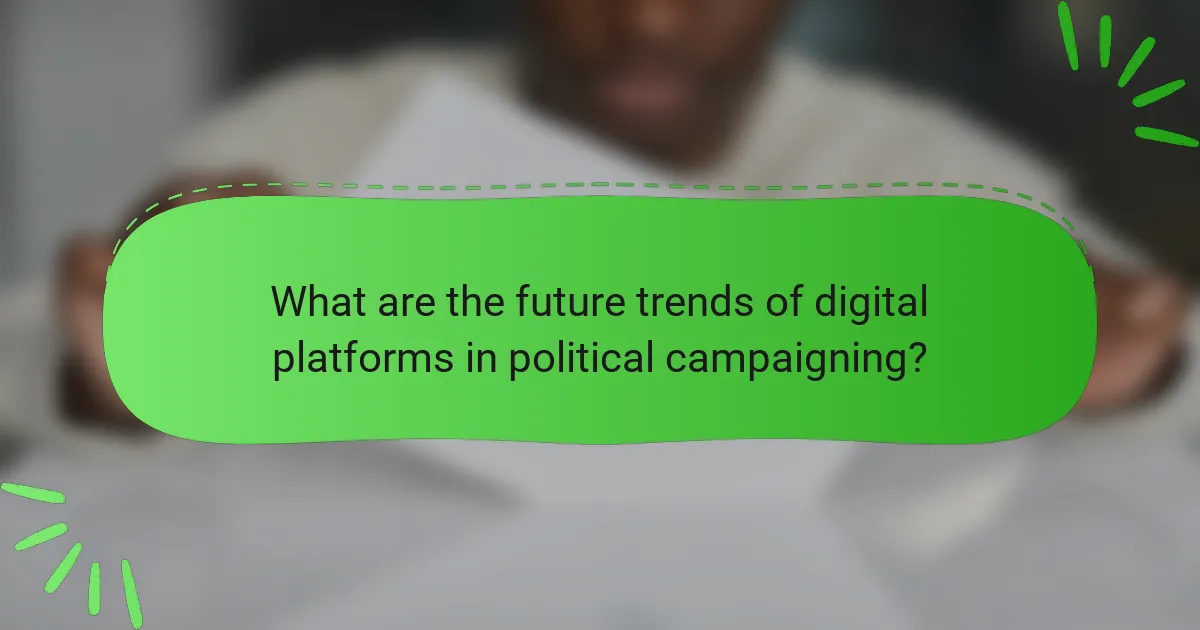Digital platforms play a crucial role in shaping political campaign strategies in the US by enabling candidates to engage with a wider audience through targeted advertising and real-time interactions. Campaigns utilize data analytics to tailor messages and optimize outreach efforts, significantly impacting voter engagement. The 2020 election highlighted the importance of social media, with a substantial percentage of voters relying on these platforms for political information. Future trends indicate a shift towards increased use of artificial intelligence, enhanced data analytics, and personalized content, alongside evolving social media features that facilitate direct communication between candidates and constituents. Additionally, regulatory changes regarding data privacy will influence how campaigns gather and utilize voter information, emphasizing the need for adaptability and transparency in political communication.

What is the Influence of Digital Platforms on Political Campaign Strategies in the US?
Digital platforms significantly influence political campaign strategies in the US. They allow candidates to reach a broader audience through targeted advertising. Social media platforms enable real-time engagement with voters. Campaigns can analyze voter data to tailor messages effectively. In the 2020 election, over 80% of voters reported using social media for political information. Digital platforms also facilitate grassroots mobilization and fundraising. The use of analytics helps campaigns optimize their outreach efforts. Overall, digital platforms reshape how candidates communicate and connect with constituents.
How have digital platforms transformed political campaigning in the US?
Digital platforms have significantly transformed political campaigning in the US. They enable targeted advertising, allowing campaigns to reach specific demographics effectively. Social media platforms facilitate direct communication between candidates and voters. This interaction creates a more engaged electorate. Data analytics tools help campaigns understand voter behavior and preferences. Campaigns can now mobilize supporters quickly through digital outreach. The 2008 Obama campaign is a notable example of successful digital strategy implementation. It utilized social media and email marketing to engage millions of voters. Overall, digital platforms have reshaped how political messages are disseminated and received in the US.
What specific digital platforms are most influential in political campaigns?
Social media platforms are the most influential digital platforms in political campaigns. Facebook, Twitter, and Instagram are primary channels for candidate outreach. These platforms enable direct communication with voters. They facilitate targeted advertising based on user data. Research shows that campaigns utilizing social media can increase voter engagement significantly. For example, a 2020 study by Pew Research Center found that 69% of Americans get news from social media. This highlights the platforms’ role in shaping public opinion and mobilizing voters. Additionally, YouTube is influential for video content and campaign messaging. Together, these platforms form a critical part of modern political strategies.
How do these platforms change voter engagement and outreach?
Digital platforms enhance voter engagement and outreach by facilitating direct communication between candidates and constituents. These platforms allow for targeted messaging based on user data. Social media channels enable real-time interaction, increasing the immediacy of political discourse. Engagement metrics show that campaigns utilizing these platforms see higher voter participation rates. For instance, the 2020 U.S. election saw a significant increase in voter turnout attributed to digital outreach efforts. Additionally, online platforms provide tools for grassroots organizing, making it easier to mobilize supporters. The ability to share information quickly broadens the reach of campaign messages. Overall, digital platforms transform traditional outreach methods into more dynamic and interactive experiences.
Why is understanding the influence of digital platforms important for political campaigns?
Understanding the influence of digital platforms is crucial for political campaigns because these platforms shape voter perceptions and behaviors. Digital platforms facilitate targeted communication, allowing campaigns to reach specific demographics effectively. For instance, 69% of Americans use social media, highlighting its role in disseminating campaign messages. Additionally, campaigns can analyze engagement metrics to refine strategies in real-time. Studies show that candidates who effectively use digital platforms can increase voter turnout by up to 15%. Therefore, leveraging digital platforms enhances outreach and engagement in modern political campaigns.
What role do digital platforms play in shaping public opinion?
Digital platforms significantly influence public opinion by facilitating information dissemination and interaction. They enable users to share content rapidly, shaping perceptions through viral trends. Algorithms prioritize certain narratives, affecting visibility and engagement. Studies show that social media can amplify misinformation, altering public beliefs. For example, a Pew Research Center study found that 64% of Americans believe social media has a major impact on political views. Additionally, targeted advertising on platforms allows campaigns to tailor messages to specific demographics, influencing voter behavior. Overall, digital platforms act as powerful tools that can both inform and mislead the public.
How do they affect campaign funding and resource allocation?
Digital platforms significantly affect campaign funding and resource allocation. They enable targeted advertising, allowing campaigns to reach specific voter demographics. This targeted approach can lead to more efficient use of funds. Campaigns can allocate resources based on real-time data analytics from digital platforms. For instance, social media insights can inform where to invest more heavily in ads. Additionally, crowdfunding through these platforms has become a vital funding source for many campaigns. According to a study by the Pew Research Center, 55% of political donations in 2020 came from online sources. This shift emphasizes the importance of digital strategies in modern campaign finance.

What strategies do political campaigns use on digital platforms?
Political campaigns utilize various strategies on digital platforms to engage voters and influence opinions. They employ targeted advertising to reach specific demographics based on data analytics. Campaigns also leverage social media for real-time communication and updates. Content marketing, including videos and articles, helps in storytelling and message dissemination. Email campaigns are used for direct outreach and mobilization efforts. Additionally, campaigns analyze engagement metrics to refine strategies continuously. According to a Pew Research study, 69% of adults in the U.S. use social media, making it a crucial tool for outreach.
How do campaigns tailor their messages for different digital platforms?
Campaigns tailor their messages for different digital platforms by adapting content to fit platform-specific characteristics. Each platform has unique user demographics and engagement styles. For example, Twitter favors concise messaging due to its character limit. This encourages campaigns to create impactful, brief statements. In contrast, Facebook allows for longer posts, enabling detailed storytelling. Instagram relies heavily on visuals, prompting campaigns to use eye-catching images and videos.
Additionally, LinkedIn targets professionals, leading campaigns to focus on policy discussions and professional achievements. Data shows that tailored messaging increases user engagement by up to 30%. By analyzing platform analytics, campaigns can refine their strategies to enhance effectiveness. This targeted approach ensures that messages resonate with the audience on each platform.
What types of content are most effective on social media?
Visual content, such as images and videos, is the most effective type of content on social media. Studies show that posts with visuals receive 94% more views than text-only posts. Engaging content, like polls and quizzes, also drives interaction. User-generated content fosters community and trust among followers. Live videos generate six times more interactions than standard videos. Infographics simplify complex information and are easily shareable. Storytelling resonates well, as it creates emotional connections. Content that encourages sharing increases reach and engagement significantly.
How do campaigns utilize data analytics in their digital strategies?
Campaigns utilize data analytics to optimize their digital strategies. They analyze voter data to identify target demographics. This helps in tailoring messages that resonate with specific groups. Campaigns track engagement metrics across digital platforms. These metrics include click-through rates and social media interactions. By understanding these metrics, campaigns can refine their content. They also use predictive analytics to forecast voter behavior. This allows for more effective resource allocation. Research shows that data-driven campaigns can increase voter turnout by up to 20%.
What are the challenges of using digital platforms in political campaigns?
Digital platforms present several challenges in political campaigns. One significant challenge is misinformation. False information can spread rapidly, undermining campaign messages. Another challenge is data privacy. Campaigns must navigate complex regulations regarding user data. Additionally, digital platforms can create echo chambers. This limits exposure to diverse viewpoints and can polarize voters. Cybersecurity threats also pose risks. Campaigns may face hacking attempts that compromise sensitive information. Lastly, the digital divide affects outreach. Not all demographics have equal access to digital platforms, which can skew campaign effectiveness.
How do misinformation and fake news impact campaign strategies?
Misinformation and fake news significantly impact campaign strategies by altering voter perceptions and behaviors. Campaigns must navigate a landscape where false information can undermine their messages. For instance, a study by the Pew Research Center found that 64% of Americans believe that misinformation causes confusion about basic facts. This confusion can lead to shifts in voter support, as individuals may align with candidates based on misleading narratives. Campaigns often respond by increasing their fact-checking efforts and adjusting their messaging to counteract false claims. Additionally, misinformation can create a sense of urgency, prompting campaigns to react quickly, sometimes without thorough vetting. The rapid spread of fake news on social media amplifies these challenges, making it essential for campaigns to engage with voters directly to clarify their positions.
What are the privacy concerns associated with digital campaigning?
Digital campaigning raises significant privacy concerns regarding data collection and usage. Campaigns often gather personal information from various online sources. This data can include browsing habits, social media interactions, and demographic details. The potential for misuse of this information is high. Unauthorized sharing or selling of personal data can occur. Additionally, targeted advertisements may exploit sensitive information without consent. Voter profiling based on personal data raises ethical questions. Legal frameworks, such as GDPR, highlight the need for transparency in data handling. Surveys indicate that many voters are unaware of how their data is used in campaigns.

What are the future trends of digital platforms in political campaigning?
Future trends of digital platforms in political campaigning include increased use of artificial intelligence, enhanced data analytics, and greater personalization of content. AI will enable campaigns to optimize messaging and target specific voter demographics more effectively. Enhanced data analytics will allow for real-time tracking of voter sentiment and engagement. Personalization will lead to tailored messages that resonate with individual voters.
Social media platforms will continue to evolve, incorporating new features that facilitate direct communication between candidates and voters. The rise of video content will dominate campaign strategies, as short-form videos engage audiences more effectively. Additionally, the use of virtual reality and augmented reality experiences will become more prevalent, offering immersive ways to connect with voters.
Furthermore, regulatory changes around data privacy will shape how campaigns gather and use voter information. Campaigns will need to adapt to these changes while maintaining transparency. Overall, the future of digital platforms in political campaigning will be characterized by innovation, adaptability, and a focus on voter engagement.
How might emerging technologies change political campaign strategies?
Emerging technologies are likely to revolutionize political campaign strategies by enhancing data analytics and targeting. Campaigns can utilize big data to analyze voter behavior and preferences. This allows for more personalized messaging and outreach. Automation tools can streamline campaign operations, making them more efficient. Social media platforms enable real-time engagement with voters, fostering direct communication. Virtual reality and augmented reality can create immersive experiences to engage voters. Additionally, artificial intelligence can optimize ad placements and content. These technologies can lead to more informed strategies and potentially higher voter turnout.
What role will artificial intelligence play in future campaigns?
Artificial intelligence will significantly enhance targeting and personalization in future campaigns. AI algorithms can analyze vast amounts of data to identify voter preferences. This enables campaigns to tailor messages to specific demographics. Machine learning models can predict voter behavior based on historical data. Additionally, AI can optimize ad placements for maximum engagement. Automation tools will streamline campaign management tasks. According to a report by the Pew Research Center, 72% of political strategists believe AI will transform campaign strategies. This indicates a strong consensus on AI’s future impact in politics.
How are digital platforms evolving to meet the needs of political campaigns?
Digital platforms are evolving to meet the needs of political campaigns by enhancing data analytics capabilities. These platforms now offer advanced tools for targeting specific voter demographics. Campaigns utilize social media algorithms to optimize ad placements. Additionally, real-time engagement features allow for immediate feedback from constituents. Enhanced video streaming options facilitate direct communication from candidates. Platforms are also integrating fundraising tools to streamline donations. Moreover, they are adopting AI technologies for predictive modeling of voter behavior. These changes reflect a growing emphasis on personalized voter outreach and engagement strategies.
What best practices should political campaigns follow when using digital platforms?
Political campaigns should prioritize authenticity and transparency on digital platforms. Engaging with voters through genuine interactions builds trust and credibility. Utilizing targeted advertising can effectively reach specific demographics. Campaigns should also focus on creating shareable content to increase organic reach. Monitoring analytics helps campaigns understand audience behavior and refine strategies. Regularly updating content keeps the campaign relevant and engaging. Collaborating with influencers can amplify the campaign’s message to wider audiences. Lastly, ensuring compliance with regulations protects the campaign from legal issues.
How can campaigns effectively measure the success of their digital strategies?
Campaigns can effectively measure the success of their digital strategies through key performance indicators (KPIs). KPIs such as engagement rates, conversion rates, and reach provide quantifiable metrics. Engagement rates indicate how well content resonates with the audience. Conversion rates show the percentage of users taking desired actions, such as signing up or donating. Reach measures the total number of unique users who see the campaign’s content.
Analytics tools like Google Analytics and social media insights offer detailed reports on these metrics. For instance, a campaign might track website traffic and social media interactions to assess effectiveness. Regularly analyzing these metrics allows campaigns to adjust strategies in real-time.
Research indicates that campaigns utilizing data-driven approaches see a 20% increase in effectiveness. This demonstrates the importance of measuring success through concrete metrics.
What ethical considerations should campaigns keep in mind when utilizing digital platforms?
Campaigns should prioritize transparency, data privacy, and honesty when utilizing digital platforms. Transparency involves clearly disclosing the sources of funding and the purpose of advertisements. Data privacy requires campaigns to handle user information responsibly and comply with regulations like GDPR. Honesty is crucial to avoid misleading claims and to maintain public trust. According to a 2020 Pew Research study, 81% of Americans feel that the potential risks of data collection by companies outweigh the benefits. Ethical campaigns should also consider inclusivity, ensuring that messaging does not alienate any demographic group. Additionally, campaigns must avoid the spread of misinformation, as it can undermine democratic processes.
The main entity of this article is the influence of digital platforms on political campaign strategies in the US. The article examines how digital platforms, particularly social media, have transformed political campaigning by enabling targeted advertising, real-time voter engagement, and data-driven strategies. It discusses the impact of these platforms on voter outreach, public opinion, campaign funding, and the challenges posed by misinformation and privacy concerns. Additionally, the article explores future trends in digital campaigning, including the role of emerging technologies and best practices for effective digital strategy implementation.